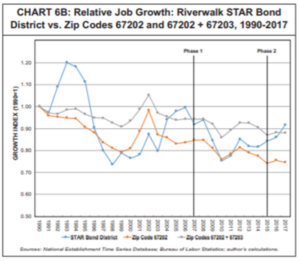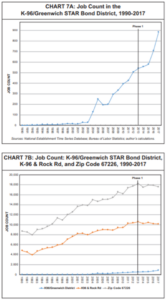As Kansas desperately searches for ways to pull itself out of the COVID-19 depression, policymakers will undoubtedly consider economic development tools as an answer. Kansas Sales Tax Anticipation Revenue Bonds, or STAR Bonds, are some of the most notable tools at the disposal of state and local governments. However, the latest research suggests that policymakers shouldn’t rely on STAR Bonds to grow jobs.
Commissioned by the Kansas Policy institute, Dr. Art Hall of KU’s Brandmeyer Center for Applied Economics examined the Wichita economy and focused on economic development tools used in the city. Specifically, Dr. Hall analyzed the job effects of two STAR Bonds in Wichita, the Riverwalk STAR Bond, and the K-96/Greenwich STAR Bond. By analyzing job trends within the STAR Bond areas and near it, Dr. Hall discovered STAR Bonds don’t create new jobs. Rather the data reveals it cannibalizes job growth that almost-certainly would’ve happened in nearby zip codes.
A STAR Bond is a bond issued by a city with its proceeds given to an outside entity to develop commercial, recreational, and tourism areas. The original goal of STAR Bonds was to promote tourism and retail activity—however, the Kansas Department of Commerce markets STAR Bonds as a tool for job growth.
 The adjacent chart* shows the relative job growth trends of the Riverwalk Star Bond district, and its surrounding zip codes 67202 and 67203 from 1990 to 2017. Notice the spike in 2002 reflected in the Growth Index; a GI picks a starting point and shows how jobs change over time. The blue line represents job growth in the area that would eventually become a STAR Bond District. The orange and grey lines correspond to jobs in their respective zip codes. The Growth Index jump in 2002 is an increase of 190 jobs in the eventual STAR Bond district. The surrounding zip codes Growth Index corresponds to a total of 2,781 jobs created in 2002. It highlights the potential connection the future STAR Bond area might have on parts of the downtown area. However, after the STAR Bond was issued (Phase 1) and reissued (Phase 2), the growth in the district had virtually zero influence on overall job change in the larger zip code areas.
The adjacent chart* shows the relative job growth trends of the Riverwalk Star Bond district, and its surrounding zip codes 67202 and 67203 from 1990 to 2017. Notice the spike in 2002 reflected in the Growth Index; a GI picks a starting point and shows how jobs change over time. The blue line represents job growth in the area that would eventually become a STAR Bond District. The orange and grey lines correspond to jobs in their respective zip codes. The Growth Index jump in 2002 is an increase of 190 jobs in the eventual STAR Bond district. The surrounding zip codes Growth Index corresponds to a total of 2,781 jobs created in 2002. It highlights the potential connection the future STAR Bond area might have on parts of the downtown area. However, after the STAR Bond was issued (Phase 1) and reissued (Phase 2), the growth in the district had virtually zero influence on overall job change in the larger zip code areas.
 A similar trend occurred in K-96/Greenwich Rd. In Chart 7A, it seems STAR Bonds can create some job growth. Two years after Phase 1 development, the district gained almost 300 jobs, moving at a faster clip than before the economic development incentive. However, the job growth displayed on Chart 7B, notes two things. The job growth in the Star Bond district pales in comparison to job growth in nearby zip codes. Second, job growth in those adjacent areas leveled off after the development of the STAR Bond. In both the Riverwalk and K-96/Greenwich Star Bonds, job growth was possibly redirected away from nearby areas into the district.
A similar trend occurred in K-96/Greenwich Rd. In Chart 7A, it seems STAR Bonds can create some job growth. Two years after Phase 1 development, the district gained almost 300 jobs, moving at a faster clip than before the economic development incentive. However, the job growth displayed on Chart 7B, notes two things. The job growth in the Star Bond district pales in comparison to job growth in nearby zip codes. Second, job growth in those adjacent areas leveled off after the development of the STAR Bond. In both the Riverwalk and K-96/Greenwich Star Bonds, job growth was possibly redirected away from nearby areas into the district.
The siphoning of nearby jobs isn’t an economic phenomenon for STAR Bonds. There’s plenty of evidence that incentives make it attractive for businesses to lobby government instead of serving Kansans. In other words, the tool encourages existing companies to lobby the government to take advantage of subsidies to their business. They focus effort on influence-peddling instead of innovating to serve customers. This mainly has the effect of jobs merely moving from one area to another instead of genuinely creating new jobs. It makes business profit not from increasing the value of goods and services to consumers. Instead, it creates profit from contracts garnered with taxpayer dollars.
Ultimately, the issue with STAR Bonds is a belief it drives new economic activity by way of government-driven strategic planning and engineering. Dr. Hall finds that economic growth occurs as an organic process. Through trial and error businesses start-up and close down until they find a market with an under-served demand. In this way, STAR Bonds as an economic development tool will rarely produce net new economic growth. Instead, policymakers must listen to businesses and remove obstacles that hinder a trial and error process.
*Chart numbers are from the original paper found here.





